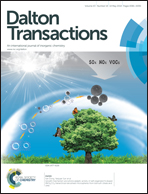A rhomboid-shaped organic host molecule with small binding space. Unsymmetrical and symmetrical inclusion of halonium ions†
Abstract
A shape persistent rhomboid-shaped organic host molecule having two pyridyl units was synthesized which induces size selective halonium inclusion. Cl+ and Br+ are included to form unsymmetric and symmetric complexes, while I+ does not form a stable complex. The difference among the haloniums was ascribed to the matching (or mismatching) of the shape of the cavity and the guest ions. The complexation of the host molecule with other cations, such as Ag+, Pd2+, Zn2+ and H+, is also mentioned.


 Please wait while we load your content...
Please wait while we load your content...